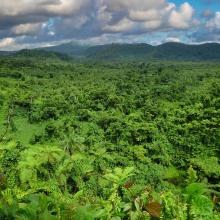


Vaipu Swamp Conservation Area
- Country:Samoa
- Site number:2530
- Area:278.3 ha
- Designation date:10-11-2023
- Coordinates:13°57'S 171°34'W
Materials presented on this website, particularly maps and territorial information, are as-is and as-available based on available data and do not imply the expression of any opinion whatsoever on the part of the Secretariat of the Ramsar Convention concerning the legal status of any country, territory, city or area, or of its authorities, or concerning the delimitation of its frontiers or boundaries.
Overview
The Site lies in a secluded area within the Eastern Upolu Catchments Key Biodiversity Area. It features the largest remaining swamp forest in the country with a mixture of lowland rain forest areas, which are important carbon sinks. It hosts diverse native plants and animals, many of which are threatened or endemic to the region, including the critically endangered tooth-billed pigeon (Didunculus strigirostris) and the endemic snails Eua expansa, Samoana conica and Succinea putamen. Some of the dominant native tree species such as the Polynesian chestnut (Inocarpus fagifer) and fasa (Pandanus turritus) are specifically adapted to areas with standing water. The immediate surroundings of the Site have remnants of the ancient villages of Vaigafa and Mauga o Alii, which are important for local tourism. Resources provided by the Site include fisheries and non-timber forest products. Some major threats include invasive species, cattle grazing and hunting, while possible hydropower development could threaten the Site in the future. Collaborative management efforts with the local landowning communities are ongoing, which are essential to ensure its long-term conservation.
Administrative region:
Vaa-o-Fonoti
- Last publication date:10-11-2023
Downloads
Ramsar Information Sheet (RIS)
Site map
Additional reports and documents
- Other published literature
